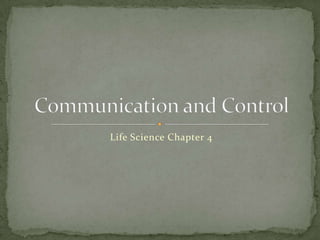Life Science 4.1: The Nervous System
•Télécharger en tant que PPTX, PDF•
3 j'aime•4,806 vues
Signaler
Partager
Signaler
Partager

Recommandé
Recommandé
Contenu connexe
Tendances
Tendances (20)
Grade 11 Earth & Life Science (Earth System & Subsystems)

Grade 11 Earth & Life Science (Earth System & Subsystems)
Module 1 Origin and Structure of the Earth Planet Earth.pptx

Module 1 Origin and Structure of the Earth Planet Earth.pptx
Biology 11 and 12: Cell modifications and specialization

Biology 11 and 12: Cell modifications and specialization
PLATE TECTONICS(GRADE10SCIENCE 1STQUARTER MODULE1)

PLATE TECTONICS(GRADE10SCIENCE 1STQUARTER MODULE1)
Introduction to Life Science and The Theories on the Origin of Life

Introduction to Life Science and The Theories on the Origin of Life
Endocrine System, Nervous System And Homeostatic Control[1]![Endocrine System, Nervous System And Homeostatic Control[1]](data:image/gif;base64,R0lGODlhAQABAIAAAAAAAP///yH5BAEAAAAALAAAAAABAAEAAAIBRAA7)
![Endocrine System, Nervous System And Homeostatic Control[1]](data:image/gif;base64,R0lGODlhAQABAIAAAAAAAP///yH5BAEAAAAALAAAAAABAAEAAAIBRAA7)
Endocrine System, Nervous System And Homeostatic Control[1]
En vedette
En vedette (20)
Similaire à Life Science 4.1: The Nervous System
Similaire à Life Science 4.1: The Nervous System (20)
Human nervous system for allied health students.ppt

Human nervous system for allied health students.ppt
Plus de Chris Foltz
Plus de Chris Foltz (20)
Earth Science 3.3 : Absolute Dating: A Measure of Time

Earth Science 3.3 : Absolute Dating: A Measure of Time
Earth Science 3.1 : Earth's Story and Those Who First Listened.

Earth Science 3.1 : Earth's Story and Those Who First Listened.
Earth Science 3.2 : Relative Dating : Which Came First?

Earth Science 3.2 : Relative Dating : Which Came First?
Dernier
This presentation was provided by William Mattingly of the Smithsonian Institution, during the fourth segment of the NISO training series "AI & Prompt Design." Session Four: Structured Data and Assistants, was held on April 25, 2024.Mattingly "AI & Prompt Design: Structured Data, Assistants, & RAG"

Mattingly "AI & Prompt Design: Structured Data, Assistants, & RAG"National Information Standards Organization (NISO)
Mehran University Newsletter is a Quarterly Publication from Public Relations OfficeMehran University Newsletter Vol-X, Issue-I, 2024

Mehran University Newsletter Vol-X, Issue-I, 2024Mehran University of Engineering & Technology, Jamshoro
This presentation was provided by William Mattingly of the Smithsonian Institution, during the third segment of the NISO training series "AI & Prompt Design." Session Three: Beginning Conversations, was held on April 18, 2024.Mattingly "AI & Prompt Design: The Basics of Prompt Design"

Mattingly "AI & Prompt Design: The Basics of Prompt Design"National Information Standards Organization (NISO)
Dernier (20)
This PowerPoint helps students to consider the concept of infinity.

This PowerPoint helps students to consider the concept of infinity.
Mixin Classes in Odoo 17 How to Extend Models Using Mixin Classes

Mixin Classes in Odoo 17 How to Extend Models Using Mixin Classes
Mattingly "AI & Prompt Design: Structured Data, Assistants, & RAG"

Mattingly "AI & Prompt Design: Structured Data, Assistants, & RAG"
Measures of Central Tendency: Mean, Median and Mode

Measures of Central Tendency: Mean, Median and Mode
SECOND SEMESTER TOPIC COVERAGE SY 2023-2024 Trends, Networks, and Critical Th...

SECOND SEMESTER TOPIC COVERAGE SY 2023-2024 Trends, Networks, and Critical Th...
Ecological Succession. ( ECOSYSTEM, B. Pharmacy, 1st Year, Sem-II, Environmen...

Ecological Succession. ( ECOSYSTEM, B. Pharmacy, 1st Year, Sem-II, Environmen...
Russian Escort Service in Delhi 11k Hotel Foreigner Russian Call Girls in Delhi

Russian Escort Service in Delhi 11k Hotel Foreigner Russian Call Girls in Delhi
Seal of Good Local Governance (SGLG) 2024Final.pptx

Seal of Good Local Governance (SGLG) 2024Final.pptx
Mattingly "AI & Prompt Design: The Basics of Prompt Design"

Mattingly "AI & Prompt Design: The Basics of Prompt Design"
Life Science 4.1: The Nervous System
- 1. Life Science Chapter 4 Communication and Control
- 2. Life Science 4.1 The Nervous System
- 3. Objectives: Describe the relationship between the central nervous system and the peripheral nervous system. Compare the somatic nervous system with the autonomic nervous system. Listone function of each part of the brain.
- 4. Two Systems Within a System Central nervous system (CNS) Your brain and spinal cord. Processes and responds to all messages coming from the peripheral nervous system. Peripheral nervous system (PNS) All of the parts of the nervous system except for the brain and the spinal cord. Connects all parts of the body to the CNS.
- 5. The Peripheral Nervous System Neuron Nerve cell that is specialized to transfer messages in the form of fast-moving electrical energy. The three parts of a neuron are : Cell body Dendrites Axon. Sensory neurons Gather information about what is happening in and around your body. Motor neurons Send impulses from the brain and spinal cord to other systems.
- 7. Nerves The central nervous system is connected to the rest of your body by nerves. Nerve Collection of axons bundled together with blood vessels and connective tissue. Most nerves have axons of both sensory neurons and motor neurons.
- 9. Somatic and Autonomic Nervous Systems Somatic Nervous System Most of these neurons are under your conscious control. Control voluntary movements such as: writing, talking, smiling, and jumping. Autonomic Nervous System Do not need your conscious control. Controls body functions that you don’t think about, such as digestion and heart rate.
- 10. The Central Nervous System The brain Largest organ of the nervous system. Main control center of the nervous system. Controls both voluntary and involuntary processes. Comprised of the cerebrum, the cerebellum, and the medulla.
- 11. Cerebrum Where you think and where most memories are stored. Controls voluntary movements and the senses. Cerebellum Processes sensory information from your body Such as : skeletal muscles and joints. Medulla Controls involuntary processes such as blood pressure, body temperature, heart rate, and involuntary breathing.
- 13. The Spinal Cord Route to the Brain The spinal cord is made of neurons and bundles of axons that pass impulses to and from the brain. The spinal cord is surrounded by protective bones called vertebrae. Spinal Cord Injury A spinal cord injury may block all information to and from the brain. Each year, thousands of people are paralyzed by spinal cord injuries.